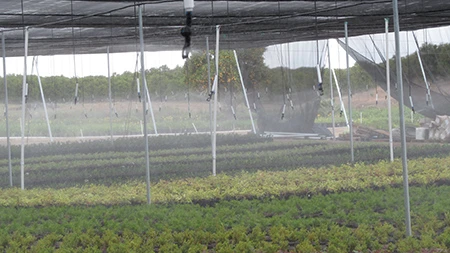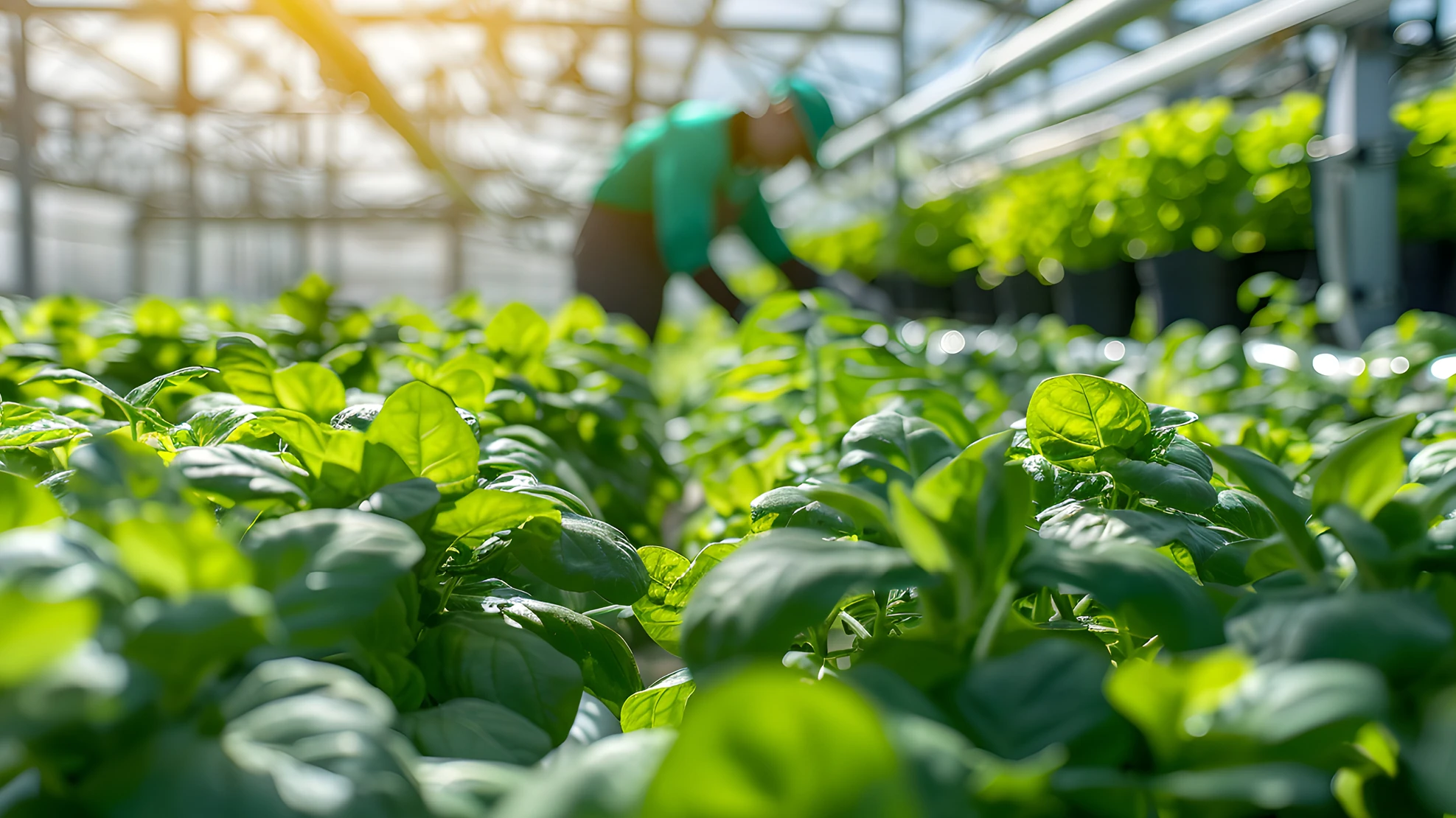
 Doug Walker, the director of University of California-Davis’s College of Biological Sciences’ greenhouse, is worried about water. His facility’s irrigation emitters are dated and force him to overuse H20. With statewide pressure pushing down on all consumers of water, Walker thinks it’s a matter of time before greenhouses are forced to monitor and alter their irrigation techniques. UC-Davis’ greenhouse is no exception.
Doug Walker, the director of University of California-Davis’s College of Biological Sciences’ greenhouse, is worried about water. His facility’s irrigation emitters are dated and force him to overuse H20. With statewide pressure pushing down on all consumers of water, Walker thinks it’s a matter of time before greenhouses are forced to monitor and alter their irrigation techniques. UC-Davis’ greenhouse is no exception.
“I have a lot to change. Many watering emitters lack anti-drip valves and are hard to shut off completely when not in use,” he says. Walker says his team tries to replace older irrigation equipment every year, but lack the funds to make wholesale changes. “We should be [concerned]. We use substantial water,” Walker says.
Drying up
The state of California is reeling from a drought that climate scientists say may be the worst in 1,200 years. In April, Governor Jerry Brown announced the first statewide mandatory water use restrictions in California’s history. When that happened, the drought became a mainstream issue. California’s ample agriculture industry has become a punching bag for the state’s 39 million residents, many of whom are feeling the squeeze for the first time. If agriculture accounts for 80 percent of all water drawn from rivers, streams and the ground, why does the average Joe have to take a five-minute shower and refrain from washing his car every week?
Gov. Brown ordered a 25 percent reduction in urban water use statewide compared to 2013 levels. His directive also banned the use of drinking water to irrigate median strips in public roads, initiated the removal of 1,150 football fields worth of grass to be replaced with drought-tolerant plants; and ordered golf courses, campuses and cemeteries to significantly cut their water consumption.
 On the agricultural side, the State Water Resources Control Board was told to crack down on illegal water diversions and “those engaging in the wasteful and unreasonable use of water.”
On the agricultural side, the State Water Resources Control Board was told to crack down on illegal water diversions and “those engaging in the wasteful and unreasonable use of water.”
Sam Sandoval Solis, assistant professor and cooperative extension specialist in water management with UC-Davis, says most of the state’s growers have already cut down on wasteful water use. His conservative estimate of California growers’ average irrigation efficiency is 78 percent. The numbers back him up. According to the USDA National Agriculture Statistics Service, California Department of Natural Resources, crop production per acre-foot of water has increased 43 percent between 1967 and 2010.
“The pointing fingers game that’s happening right now will not create one more drop of water,” Solis says. “We need water conservation and irrigation efficiency and also the use of recycled water and water treatment plants and better education at all levels. This is not complicated, but it is exhaustive.”
Solis supports the governor’s drought restrictions, because they have effectively brought the drought to the whole Californian society — not just the agricultural community that has been dealing with the drought’s impacts for the last few years. California agriculture is a $300 billion juggernaut that is larger than the economy of four states on its own, according to the U.S. Department of Commerce. And it has been taking its lumps. More than 692,000 acres of California farmland were fallowed in 2014 as a result of the drought. That’s an area only slightly smaller than Yosemite National Park.
Help isn’t coming from the usual source, either. The snowpack in the Sierra Nevada, which is usually an essential source of water in the summer as it melts, hit record lows this year — 5 percent of normal in April — following the driest winter since records have been kept.
The U.S. Drought Monitor maps and measures drought conditions and provides forecasts. The maps are updated weekly and produced jointly by the National Oceanic and Atmospheric Administration, the U.S. Department of Agriculture, and the National Drought Mitigation Center (NDMC) at the University of Nebraska-Lincoln. Drought conditions are assigned a category from D0 to D4 based on their severity. The most recent drought map of California showed slight improvements and one worrying fact. At the beginning of 2015, 78 percent of California was categorized as D3 or D4, or in a state of extreme or exceptional drought. As of May 26, that number had dropped to 67 percent. However, more of the state is suffering from D4-level drought — 47 percent, compared to 32 percent on Jan. 1.
 The drought has affected the horticultural industry in a wide range of ways. April and May are typically the two busiest months for growers and retailers, and business has been flagging. Scott Klittich, chairman of the California Association of Nurseries and Garden Centers, has talked often with members about how the drought has affected them. He estimates a 20 to 25 percent decrease in business across the board. The governor’s restrictions have created a situation in which homeowners and gardeners have to think hard about whether they want to use their water allotment on a new plant or in another facet of their lives. If the end user isn’t buying, it creates a trickle-up effect.
The drought has affected the horticultural industry in a wide range of ways. April and May are typically the two busiest months for growers and retailers, and business has been flagging. Scott Klittich, chairman of the California Association of Nurseries and Garden Centers, has talked often with members about how the drought has affected them. He estimates a 20 to 25 percent decrease in business across the board. The governor’s restrictions have created a situation in which homeowners and gardeners have to think hard about whether they want to use their water allotment on a new plant or in another facet of their lives. If the end user isn’t buying, it creates a trickle-up effect.
David House, CEO of Village Nurseries, says the drought has presented a set of challenges as well as opportunities. The Orange, Calif.-based wholesale grower has 900 acres of growing facilities in Northern and Southern California, as well as four landscape centers for easier service for their landscape customers. “It has forced us to think harder about our irrigation practices, even though the latest governor-mandated restrictions and cutbacks did not hit agriculture, we still take it very seriously and are continually looking for ways to reduce the water we use,” House says. “Since the water cutbacks were mandated, it has been hurting demand at the retail level, so the end user, the retail consumer and the homeowner have seen roughly a 15 percent softening of sales. People are concerned about spending their discretionary dollars on plants for two reasons: Will they live? And is it the right thing to do?”
Irrigation methods
Heiner Lieth, crop ecologist at UC-Davis, says that hydroponic growing has become vastly more popular in the last five years, in large part due to the drought. “I’m not even sure exponential is the best way to put it,” he says. “It’s propelling upwards like crazy.”
“Once a grower gets into hydroponics, they realize they can do the same amount of production with a lot less water. It may look like there’s more water, but you’re usually reusing it. So you only discard the water once you’ve gotten it to a point that you can no longer use it,” he says.
 For his colleague at UC-Davis, Doug Walker, an aging greenhouse facility is a concern.
For his colleague at UC-Davis, Doug Walker, an aging greenhouse facility is a concern.
“At our old facility the irrigation controllers are lacking. One of my managers has set up a controller using Raspberry Pi and software by OpenSprinkler,” he says. “It’s a test setup that's been running successfully for only a week. I’m hoping it provides better control of irrigation to reduce water and fertilizer use. The system costs much less than our current controllers but one needs to have an advanced computer skill set to implement it.”
Village Nurseries is installing a new irrigation system at its Steele Valley facility on 10.6 acres of shade structure. The system is composed of suspended modular sprinklers that allow freedom of activity below them and remain unobstructed by taller plant material. The individual sprinklers put out lower gallons per minute than conventional overhead sprinklers, and the density and uniformity of their output shown in field audits is at least 20 percent more efficient than conventional impact overhead irrigation. Each sprinkler can be turned off individually to allow the nursery not to water open areas.
“We’ve found that this type of system allows us to eliminate second cycles most of the year and reduces the need for supplemental hose irrigation needed with other overhead systems,” House says.
Village Nurseries is also using more reclaimed water where it’s available at some of its facilities. House says he’s checking into the economic feasibility of a system that would combine water cleaning and irrigation to allow the use of 100 percent reclaimed water at an 180-acre facility. Village Nurseries is also running more night crews to water when it’s most efficient.
Crop choices
Monterey Bay Nursery, wholesale growers of container ornamentals and color crops, has seen a shift in the plants most often requested. Before the drought took hold, the grower always sold a decent amount of drought-tolerant plants from the Mediterranean climate. The demand for those types of plants from South Africa, Australia and the Mediterranean have increased.
“We respond to what sells,” Luen Miller, the president and co-owner of Monterey Bay Nursery says. “And there has been an increasing demand for the more difficult to propagate, drought-tolerant plants from climates similar to California, which don’t have as many cultural problems as California natives do.”
 Miller says there has always been a strong demand for these plants in California because besides being drought-tolerant, which most of them are, they’re easier to care for in yards. California natives tend to be relatively uncompromising during the hot, dry period; thirsty plants just aren’t selling anymore.
Miller says there has always been a strong demand for these plants in California because besides being drought-tolerant, which most of them are, they’re easier to care for in yards. California natives tend to be relatively uncompromising during the hot, dry period; thirsty plants just aren’t selling anymore.
“A lot of the water-demanding plants have just been falling off and falling out of the trade because designers don’t use them, nurseries don’t buy them,” Miller says. “It’s been a general trend by all users and all growers to shift into a drier, harder, more drought-tolerant and more water-conserving palette.”
House says there has been a shift, but it hasn’t been immediate. Village Nurseries has been gradually transitioning over the last 10 to 15 years to more succulents, which are very low water users, and more native California plant material. He says the plants that are selling well are widely known as drought tolerant. He’s anticipating a shortage of those plants. But one of his goals is to help consumers understand that they don’t need to restrict themselves to a narrow plant palette to be drought tolerant.
Educate your customer
Aside from being chairman of the board CANGC, Klittich is the owner of Otto & Sons Nursery, a nursery and retail operation; giving him the opportunity to educate the consumer directly. The homeowners that are the end of the supply chain don’t think they can keep a plant alive under the state’s water restrictions, and growers and retailers need to help them understand that they can.
He uses the company’s newsletter as a way to educate customers about water conservation.
“The one good thing about the drought is it is making everyone more aware of their yards and landscaping,” Klittich says. “Constantly having the drought on the front page of the newspaper is bringing everyone’s focus to their landscape and gardens. That’s a good thing that they are looking at their gardens and seeing how they can improve upon them. Having that conversation and talking to people about putting lots of mulch on your soil to reduce water evapotranspiration and feed your soil. Having drip irrigation. Use organic fertilizer so you don’t get a big push of growth. Those conversations are conversations we’ve always had, but now are being highlighted. We can bring those out and people understand them a lot better.”
Klittich has urged CANGC members to have conversations with their customers about using mulch to reduce water evapotranspiration and feed the soil. These are conversations many growers and retailers are already having with their customers, but now that the drought has heightened everyone’s awareness of water conservation and importance. Green industry businesses are ideally positioned for a role as drought expert.
Matt McClellan is managing editor for Nursery Management. Greenhouse Management assistant editors Cassie Neiden and Chris Mosby contributed to this article.

Explore the June 2015 Issue
Check out more from this issue and find your next story to read.
Latest from Greenhouse Management
- 2025 Proven Winners Horticulture Scholarship applications now open
- How to improve inventory and shipping management in the greenhouse
- Leading Women of Horticulture: Anna Ball, Ball Hort, and Terri McEnaney, Bailey Nurseries
- GM CEA HERB Part 2: A guide to increasing the sowing density of culinary herbs
- GM CEA HERB Part 1: Best practices for producing culinary herbs in controlled environments
- USDA fires experts on invasive pests, including Asian citrus psyllid, chilli thrips
- CEA Alliance celebrates bipartisan introduction of Supporting Innovation in Agriculture Act
- Dümmen Orange North America celebrating 25th anniversary in 2025





